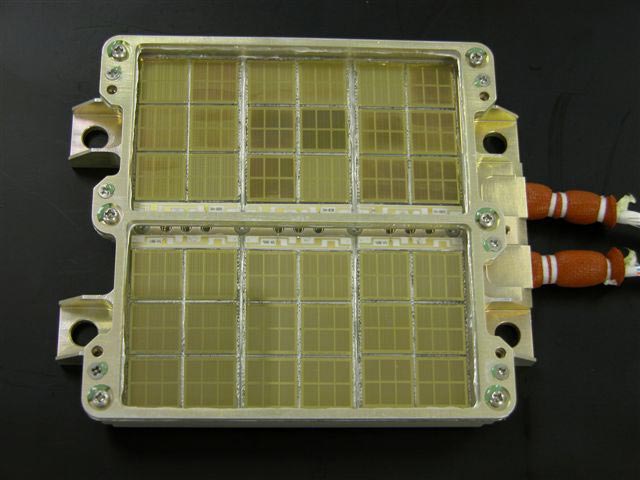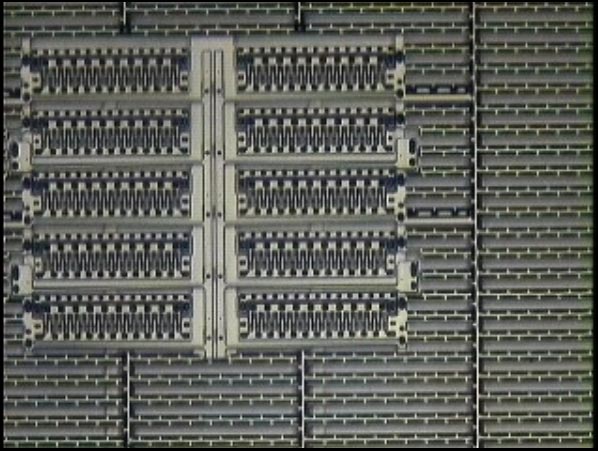Press Release
Microscopic Radiator Flying on "Skin" of a NASA Spacecraft
Mon, 03/13/2006 - 10:36
A small team of researchers from The Johns Hopkins University Applied Physics Laboratory (APL) in Laurel, Md., in conjunction with NASA Goddard Space Flight Center (GSFC), have developed a novel radiator so small its components are only visible under a microscope. The temperature control device, formally known as the "Variable Emittance (Vari-E) Coatings for Thermal Control," is based on MicroElectroMechanical Systems (MEMS) technology employing shutters so small that several abreast are smaller than the width of a single human hair.
When NASA's Space Technology 5 (ST5) satellites launch no earlier than March 21, one of the three overhead projector-sized micro-satellites will be "wearing" this device on its "skin" to demonstrate that MEMS-based technology can be used to regulate the temperature of a satellite or one of its instruments.
"This is the first time a fully space-qualified device of this type has ever been flown, and the first to be flown on the outside of a satellite," says Ann Darrin, APL's Vari-E program manager, who explained that the devices underwent the same rigorous tests that all space products undergo prior to launch. "It's also the first demonstration of MEMS technology used to actively control temperature."
In a 4-inch square section atop one of the micro-satellites, tiny comb-shaped motors powered by electrostatic charges open and close microscopic shutters to regulate the temperature of that area of the satellite. "When a satellite's in space, you need to keep its temperature constant," says Darrin. "As we shrink the size of satellites and their onboard systems, it becomes harder to regulate and maintain a constant temperature. By putting these devices on the outside or ‘skin' of a satellite you can change its emissivity.
"When the satellite is facing the sun, for example, you could cool it by closing our shutter doors and reflecting the heat," Darrin says. "Or if you need to absorb more heat, the shutters would open."
The 4-inch square radiator contains 36 chips, each about the size of a single key on a computer keyboard. Looking at a chip under a microscope, one could see 72 shutter segments, each driven back and forth by six tiny motors controlled from the electrostatic charge-based power source located inside the satellite.
To protect the tiny devices from dust and condensation, which could hinder their operation, the team developed a unique packaging solution. They encased the devices in a "window" using a clear material known as CP-1, a polymer rugged enough to sit on the outside of a satellite during space-based operations, and more cost-effective than materials like single crystal (clear, not blue jewelry quality) sapphire.
"Often people associate small with being frail," says Darrin. "But our tiny shutters, which don't touch when they close, are exceptionally strong, especially when operating in space where there's no gravity, weight or resistance forces to wear or degrade moving parts."
According to Darrin, the very small, lightweight devices could shave off numerous pounds from a micro-sat, resulting in smaller radiators, for example, and making the overall micro-sat more efficient and cost-effective.
APL is the principal investigator of the Variable Emittance devices, which were fabricated by Sandia National Laboratories in Albuquerque, N.M.
The ST5 satellites, currently scheduled for launch from Vandenberg Air Force Base, Calif., no earlier than March 21, will provide a platform for testing and validating new technologies. For more information about the ST5 mission and its onboard technologies being tested, visit http://www.nasa.gov/mission_pages/st-5/main/index.html.
The ST5 project, managed by NASA GSFC, is part of NASA's New Millennium Program created to identify, develop, build and test innovative technologies and concepts for infusion into future missions.

